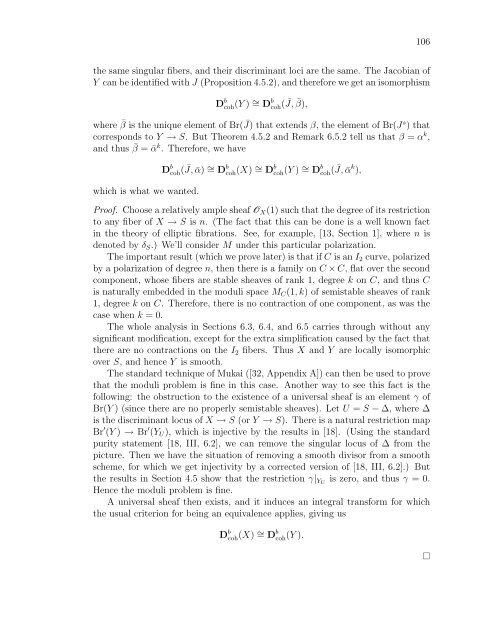derived categories of twisted sheaves on calabi-yau manifolds
derived categories of twisted sheaves on calabi-yau manifolds
derived categories of twisted sheaves on calabi-yau manifolds
Create successful ePaper yourself
Turn your PDF publications into a flip-book with our unique Google optimized e-Paper software.
106<br />
the same singular fibers, and their discriminant loci are the same. The Jacobian <str<strong>on</strong>g>of</str<strong>on</strong>g><br />
Y can be identified with J (Propositi<strong>on</strong> 4.5.2), and therefore we get an isomorphism<br />
D b coh(Y ) ∼ = D b coh( ¯ J, ¯ β),<br />
where ¯ β is the unique element <str<strong>on</strong>g>of</str<strong>on</strong>g> Br( ¯ J) that extends β, the element <str<strong>on</strong>g>of</str<strong>on</strong>g> Br(J s ) that<br />
corresp<strong>on</strong>ds to Y → S. But Theorem 4.5.2 and Remark 6.5.2 tell us that β = α k ,<br />
and thus ¯ β = ¯α k . Therefore, we have<br />
which is what we wanted.<br />
D b coh( ¯ J, ¯α) ∼ = D b coh(X) ∼ = D b coh(Y ) ∼ = D b coh( ¯ J, ¯α k ),<br />
Pro<str<strong>on</strong>g>of</str<strong>on</strong>g>. Choose a relatively ample sheaf OX(1) such that the degree <str<strong>on</strong>g>of</str<strong>on</strong>g> its restricti<strong>on</strong><br />
to any fiber <str<strong>on</strong>g>of</str<strong>on</strong>g> X → S is n. (The fact that this can be d<strong>on</strong>e is a well known fact<br />
in the theory <str<strong>on</strong>g>of</str<strong>on</strong>g> elliptic fibrati<strong>on</strong>s. See, for example, [13, Secti<strong>on</strong> 1], where n is<br />
denoted by δS.) We’ll c<strong>on</strong>sider M under this particular polarizati<strong>on</strong>.<br />
The important result (which we prove later) is that if C is an I2 curve, polarized<br />
by a polarizati<strong>on</strong> <str<strong>on</strong>g>of</str<strong>on</strong>g> degree n, then there is a family <strong>on</strong> C × C, flat over the sec<strong>on</strong>d<br />
comp<strong>on</strong>ent, whose fibers are stable <str<strong>on</strong>g>sheaves</str<strong>on</strong>g> <str<strong>on</strong>g>of</str<strong>on</strong>g> rank 1, degree k <strong>on</strong> C, and thus C<br />
is naturally embedded in the moduli space MC(1, k) <str<strong>on</strong>g>of</str<strong>on</strong>g> semistable <str<strong>on</strong>g>sheaves</str<strong>on</strong>g> <str<strong>on</strong>g>of</str<strong>on</strong>g> rank<br />
1, degree k <strong>on</strong> C. Therefore, there is no c<strong>on</strong>tracti<strong>on</strong> <str<strong>on</strong>g>of</str<strong>on</strong>g> <strong>on</strong>e comp<strong>on</strong>ent, as was the<br />
case when k = 0.<br />
The whole analysis in Secti<strong>on</strong>s 6.3, 6.4, and 6.5 carries through without any<br />
significant modificati<strong>on</strong>, except for the extra simplificati<strong>on</strong> caused by the fact that<br />
there are no c<strong>on</strong>tracti<strong>on</strong>s <strong>on</strong> the I2 fibers. Thus X and Y are locally isomorphic<br />
over S, and hence Y is smooth.<br />
The standard technique <str<strong>on</strong>g>of</str<strong>on</strong>g> Mukai ([32, Appendix A]) can then be used to prove<br />
that the moduli problem is fine in this case. Another way to see this fact is the<br />
following: the obstructi<strong>on</strong> to the existence <str<strong>on</strong>g>of</str<strong>on</strong>g> a universal sheaf is an element γ <str<strong>on</strong>g>of</str<strong>on</strong>g><br />
Br(Y ) (since there are no properly semistable <str<strong>on</strong>g>sheaves</str<strong>on</strong>g>). Let U = S − ∆, where ∆<br />
is the discriminant locus <str<strong>on</strong>g>of</str<strong>on</strong>g> X → S (or Y → S). There is a natural restricti<strong>on</strong> map<br />
Br ′ (Y ) → Br ′ (YU), which is injective by the results in [18]. (Using the standard<br />
purity statement [18, III, 6.2], we can remove the singular locus <str<strong>on</strong>g>of</str<strong>on</strong>g> ∆ from the<br />
picture. Then we have the situati<strong>on</strong> <str<strong>on</strong>g>of</str<strong>on</strong>g> removing a smooth divisor from a smooth<br />
scheme, for which we get injectivity by a corrected versi<strong>on</strong> <str<strong>on</strong>g>of</str<strong>on</strong>g> [18, III, 6.2].) But<br />
the results in Secti<strong>on</strong> 4.5 show that the restricti<strong>on</strong> γ|YU is zero, and thus γ = 0.<br />
Hence the moduli problem is fine.<br />
A universal sheaf then exists, and it induces an integral transform for which<br />
the usual criteri<strong>on</strong> for being an equivalence applies, giving us<br />
D b coh(X) ∼ = D b coh(Y ).
















